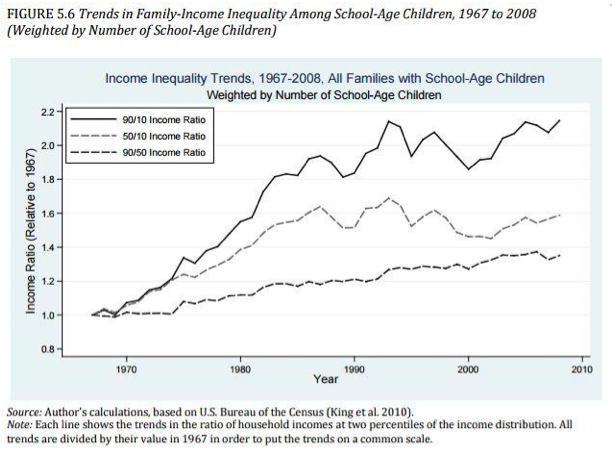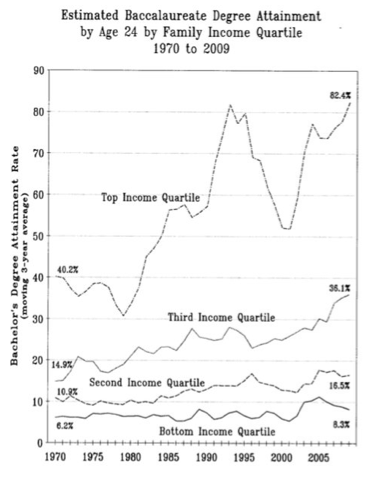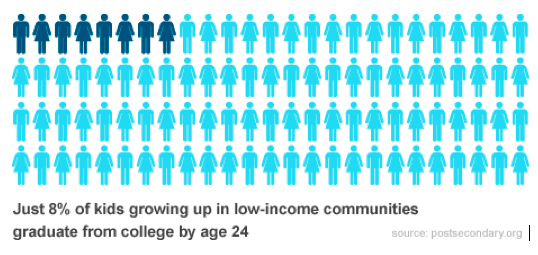Introduction
You have heard – including from us here at BBA – that the Broader, Bolder Approach to Education is grounded in evidence of poverty’s impacts on student success, and of effective strategies to mitigate them. You want to make the case to your friends so they will sign on, and to your school board members and community leaders so that your school can do what it takes to give all children an equitable, excellent educational experience. Or to your graduate students, who need to understand the many ways that education and poverty intersect, so that they can go change our education system and the world for the better. But you don’t know where to start.
Introducing BBA101. This “MOOC” gives you everything you need, in class-sized doses, to educate yourself and, if you’d like, others, on this important subject. Each month, you’ll find a new session with everything you’d expect to find in a classroom (except the teacher and other students). It is designed so that you can go through it alone or with a friend, session-by-session or occasionally, based on your specific interests. Each session includes:
- “Required” and “optional” reading lists. The former are seminal chapters and articles – “must reads” – from some of the preeminent scholars in the field, and the latter are excellent but often more in-depth or challenging pieces that you might want to take on if this session’s topic is of particular interest.
- Graphics and data: Illustrations of 2-3 of the most important and surprising data points or trends featured in the readings, with captions to explain what you’re seeing and why you might want to share it. This helps crystallize core points from the week and what you want to take away from the session.
- Video: Where possible, we feature a video (or audio) presentation from one of the experts whose work is featured. While he or she may not be speaking to the article’s topic or point, this is a way to get a general sense of the week’s main points, and also an alternative if you prefer this to the more academic articles.
- Book Club Recommendations: We want you to share this MOOC far and wide. And we know that everyone learns differently. So maybe discussing a few of the key highlights of this session with friends over wine and cheese works better for you than going through the data and analysis in their original format.
- Study Questions: Finally, we offer a set of questions that will help you sort through the material, whether it’s with your book club or in preparation for a mock “quiz.”
Contents
Required Reading
- Richard Rothstein (2004). Chapter 1 in Class and Schools: Using Social, Economic And Educational Reform To Close The Black-White Achievement Gap, (pp.1-59). Economic Policy Institute. Widely considered the “bible” for evidence of the connections between poverty and education, this book stands the test of time.
- David Berliner (2009). Poverty and Potential Out-of-School Factors and School Success Boulder and Tempe: Education and the Public Interest Center & Education Policy Research Unit. Berliner is one of the foremost scholars on this subject; this brief focuses in particular on health-related impediments to low-income children’s academic success.
- Helen Ladd (2011). Education and Poverty: Confronting the Evidence. Presidential Address to the Association for Public Policy Analysis and Management in Washington, D.C
- Greg Duncan and Richard Murnane (2011). Whither Opportunity: Rising Inequality, Schools, and Children’s Life Chances. Russell Sage. (Introduction, pp.3-23). This seminal compendium of scholarly articles starkly illustrates how growing US societal socioeconomic inequalities are being replicated, and even compounded, in American schools. See Executive Summary.
- Prudence L. Carter and Kevin G. Welner (2013). Closing the Opportunity Gap: What America Must Do to Give Every Child an Even Chance. Oxford Press. (Introduction pp.1-10). This three-part collection of scholarly essays effectively counters the education reform narrative that points to low standards and weak teaching, rather than large disparities in opportunities to learn, as the critical problem facing children and school.
Optional Reading List
- http://educationandpovertycivilrights.blogspot.com This collection of commentaries from BBA co-chair Pedro Noguera and others provides a civil rights perspective on the issue.
- National Center for Children in Poverty research, http://nccpreports.blogspot.com/ These commentaries reflect the perspective of child poverty experts and advocates.
- Letourneau, Nicole Lyn; Duffett-Leger, Linda; Levac, Leah; Watson, Barry; Young-Morris, Catherine Socioeconomic Status and Child Development: A Meta-Analysis Journal of Emotional and Behavioral Disorders, 2013. As described in the abstract, a number of factors mediate the relationship between socioeconomic status and school achievement. (full article requires payment).
- Nelson, C. and Sheridan, M (2012). “Lessons from Neuroscience Research for Understanding Causal Links between Family and Neighborhood Characteristics and Educational Outcomes.” in Duncan, G.J. & Murnane, R. (eds), Whither Opportunity? Rising Inequality, Schools, And Children’s Life Chances. This chapter includes a brief review of developmental neurobiology and its significance for factors shaped by families, schools, and neighborhoods; it includes recommendations for cost-effective early intervention.
Graphics & Data
Growing gaps in educational attainment are explained in large part by sharply increasing gaps in family income. As researchers document, such large disparities in resources mean that parents are able to provide very different levels of enrichment and support to their children.
In recent decades, the sharp increase in Americans with bachelor’s degrees has been driven almost entirely by growth in the top half of the income scale, with no growth at all among the bottom 25%.This fact represents – and drives – a major facet of our societal inequities.
In an era in which educational attainment predicts life chances more than any time in history, this graphic reflects the series of obstacles that disadvantaged students, particularly those growing up in poor communities, face starting from birth.
Video
Pedro Noguera delivers the 2011 UVA Ridley Lecture, titled “A Broader, Bolder Approach to Education,” outlining BBA principles and recommendations for addressing poverty-related impediments to learning that diminish opportunities too many American children.
Book Club Recommendation
If a MOOC session is not your thing, try suggesting this for your next book club instead. These follow the same theme as the more scholarly articles listed above, but make for good discussion over crackers, cheese, and wine.
- Kozol, Jonathan. Savage Inequalities. This classic work is based on journalist Jonathan Kozol’s visits between 1988 and 1990 to schools in burnt-out Camden, N.J., Washington, D.C., New York’s South Bronx, Chicago’s South Side, San Antonio, Tex., and East St. Louis, Mo., where virtually all students were nonwhite. Kozol offers insightful, heart-rending and eminently humane looks at how children from poor families are cheated out of a future by grossly underequipped, understaffed and underfunded schools in U.S. inner cities and less affluent suburbs.
Study Questions
Question #1
Rothstein, Berliner, Ladd, and others all point to poverty as the single largest factor affecting student success. Are they talking about poverty itself, or various factors related to it? Which of those strikes you as posing the largest barriers to success and why?
Question #2
Standards-based reform—described as the three-legged stool of standards, assessment and accountability—has been the dominant framework guiding education policy for over three decades. In light of the opportunity-to-learn issues raised by Duncan, Murnane, Carter, and Welner, what is the case for incremental changes to this framework in order to effectively address persistent achievement gaps? Or if a radically new framework is needed, what are the broad contours of one that addresses both in-school and out-of-school factors?
Question #3
In Whither Opportunity, Reardon’s research finds that the relationship between family socioeconomic status and academic achievement has strengthened over the past decade. He explains this by the increasing investment by wealthier families in out-of-school enrichment activities such as music lessons and tutoring. This reality, along with the widening social inequality in America, seems to undermine the American ideal that public education is a great equalizer and vehicle of social mobility. Given the contrast between policies that aim to reduce poverty and those that ameliorate its effects, which other reforms are needed to restore education as a great equalizer?
Optional: For Further Investigation
Question #1
In light of the significant research presented by Rothstein and Reardon on the impact of health care, nutrition, parents, home and community on the achievement gap, what recommended policies (e.g. earned income tax credits, school-community health clinics, affordable housing, early childhood education, after-school and summer programs) do you find most promising for the school district you are investigating or that serves your children? A new endeavor in the philanthropic community is called “collective impact.” Collective Impact reverses the traditional nonprofit social change process. Traditionally, a nonprofit identifies an isolated need, creates a service for that need, demonstrates results, and scales their service to more people in hopes of creating larger societal change. Collective Impact instead begins with changing the community overall and works backward. See seminal article in the Stanford Social Innovation Review. What community stakeholders are likely to help initiate a broader approach for collective impact in improving the schools in this district?
Question #2
In Whither Opportunity?, edited by Duncan and Murname, the American promise of social mobility through educational equity has been seriously eroded in the past three decades of widening social and economic inequality; in fact, the correlation between family income and wealth and the educational attainment of children has strengthened over this period and perhaps calls into the question the capacity of American schools to perform this historic role of promoting equity. This correlation, known as the “iron law” of education policy, however, has been successfully overcome in countries like Finland and Canada (see Pasi Sahlberg, Finnish Lessons). What factors have strengthened this correlation in the American context and what corresponding policies could address them, given or in spite of international differences in political economy (i.e. the American emphasis on free market ideology)?
Question #3
In Closing the Opportunity Gap: What America Must Do to Give Every Child an Even Chance, Carter and Welner argue that opportunity to learn is the essential condition for every child to learn and achieve their potential and yet it has been ignored and even dismissed by policymakers in the standards-based reform era as an “excuse” for the failure of schools in high-poverty communities. Opportunity to learn is actually a legal principle established by Title VI of the Civil Rights Act of 1964 and has a long case law history. In recent decades, advocates for equity, however, have been generally unsuccessful in using opportunity to learn in courts (e.g. see this summary by FAIRTEST on the decision in G.I. Forum et al. v Texas Education Agency, where plaintiffs failed to win even though showing that high stakes “exit level” tests had a disparate impact on minority students). Nevertheless, groups like the Lawyers Committee for Civil Rights under Law, NAACP and NUL continue to seek to leverage the law to ensure the federal role in ensuring equity in schools (see this 2010 framework for reauthorizing ESEA). What do you consider the promise and the challenges in using opportunity to learn as a strategy to improve America’s schools?


